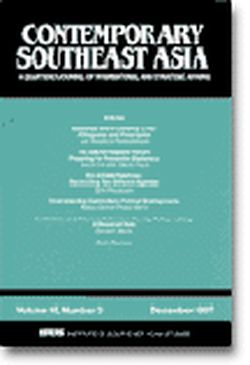Contemporary Southeast Asia: A Journal of International and Strategic Affairs Vol. 16/4 (Mar 1995)

Date of publication:
March 1995
Number of pages:
109
Code:
CS16/4
Contents
-
Preliminary pages
- ARTICLES
-
Domestic Inhibitions to a Leadership Role for Japan in Pacific Asia, by Peter W Preston , author see abstractIn the wake of the end of the Cold War the attention of commnetators has turned to the dynamics of the global system. In this context, the rise of a Paicfic Asian sphere with an increasingly tripolar world is of great interest. The core economy within this nascent regional grouping is Japan. It has been suggested that Japan could be about to begin moves towards an overt leadership role within Pacific Asia. A series of internal reforms would be necessary before such a role could be adopted. Int his context, the recent fluidity of the Japanese political system is of considerble interest as it raises the possibility of significant structural changes within Japan and, thereafter in the linkages of the Japanese system to wider regional and lgobal systems. However, a review of a series of areas of possible rereconstruction in the polity, the economy, the society, the culture and the linkages of Paicifc Asia clearly points ot a rational expectation of contiuned stability. Nowithstanding the recent unusual political turbulence, Japan is not in the process of rapid change and, over the next few years, is likely to be concerned,a s it has been since the Meiji restoration, with safely managing its now deepening relationships with pacific Asia.
-
A Test Case for China's Defence and Foreign Policies, by You Ji, author see abstractThe South China Sea has increasingly assumed an important place in the People's Liberation Army's (PLA) contingency plans for limited war. This is largely due to China's claim to the Spratly Islands - a sprawling archipelago which is contested in whole or in part by several other countries. The Spratlys constitute a significant test case for China's defence and foreign policies. Preparations for potential conflict over the Spratlys have already forced changes to the PLA Navy's force structure and doctrine. Yet, Chinas foreign policy is dictated by opposing, rather than straightforward, impulses: one driven by irredentism, while another seeks to give evidence of a responsible country among the community of nations in an increasingly interdependent world.
-
The ASEAN Triad: Interest, Consensus-Seeking, and Economic Co-operation, by Bilson Kurus, author see abstractAFTA represents the most visible test of ASEAN's resolve on the question of economic co-operation. While ASEAN's past experience in economic co-operation has not been very encouraging, the changing regional and global environment brings with it the added imperative that the future of ASEAN itself may be irrevocably linked to the success of AFTA. The ability of the ASEAN states to reconcile conflicting interests and motivation with the need for a more pragmatic and proactive approach is now, more than ever before, being put to the test. Recent developements vis-[agrave]-vis AFTA suggest that ASEAN is moving in the right direction.
-
The Foreign Policy Dimensions of Subregional Economic Zones, by Donald E Weatherbee, author see abstractThe study of foreign policy in Southeast Asia in recent years has focused on the processes and structures of regionalism, especially ASEAN. Truly integrative activity has not been a region-wide phenomenon. It has been subregional in the formation of socalled "economic growth zones" or "natural economic territories". Analysis of subregionalism has tended to be limited to the economic functions performed within them; involving as they do national state actors in their creation and development, subregional zones are also an appropriate category for political analysis. Some initial hypotheses are offered in this article to explain the foreign policy impact of subregional economic zones in a comparative analysis.
-
The Khmer Rouge and the Crisis of Vietnamese Settlers in Cambodia, by Zachary Abuza, author see abstractThe ability of the Khmer Rouge to both mobilize the population against the Vietnamese minority, and to sustain the popular belief that they are the only force within Cambodia capable of protecting the country from Vietnamese "annexation" will be a major factor in the success of their movement. The Khmer Rouge target the Vietnamese settlers not just out of historical animosity but as a key component of their domestic political struggle. As a low-cost, popular measure that gives their movement a degree of legitimacy and pressures the Royal Government, both domestically and internationally, the Khmer Rouge can be expected to continue to target the local Vietnamese community.
-
The Changing Dimensions of U.S. National Security Strategy: A Review Article, by Leonard C Sebastian, author see abstractGrand Strategy and the Decision-making Process. Edited by James C. Gaston. Washington: National Defense University Press 1991. 371 pp.; Command and Control for War and Peace. By Thomas P. Coakley. Washington: National Defense University Press, 1991. 219 pp.; Importance of Non-military Dimensions; Decision-making and Changes in Warfare; Understanding Strategic Command and Control Issues; Burden-sharing and Strategic Command and Control Issues; The Changing International Environment The Context for Improved U.S. Strategy towards Asia; Conclusion.
-
INDEX





